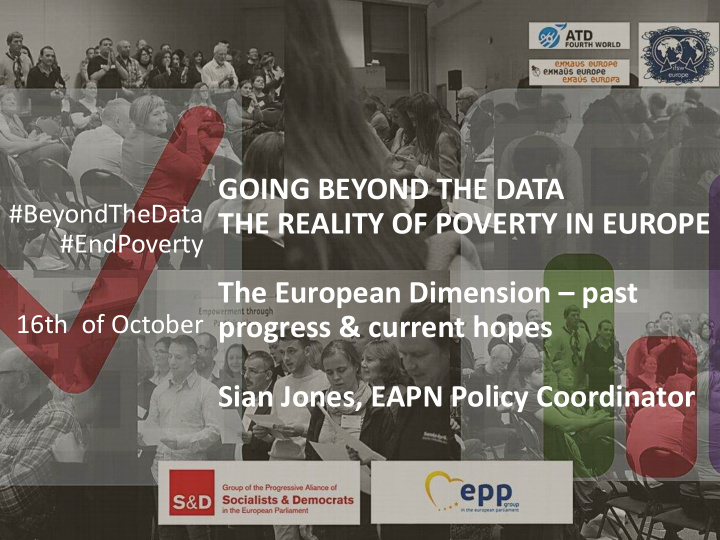



GOING BEYOND THE DATA #BeyondTheData THE REALITY OF POVERTY IN EUROPE #EndPoverty The European Dimension – past 16th of October progress & current hopes Sian Jones, EAPN Policy Coordinator
Outline of the Presentation 1. Introduction to EAPN 2. What’s is poverty and what is happening to it ? 3. What progress? 4. What role for the EP and Intergroup? 5. Way forward
What is EAPN - the European Anti Poverty Network? • Largest independent network of NGOs committed to fight against poverty and social exclusion in Europe, with & for people in poverty • Started in 1990 – key actor in poverty programmes and development of social Open Method of Coordination, the Lisbon Strategy, and Europe 2020 and the European Semester • Receives financial support from the European Commission (EaSI programme) • 32 National Networks and 13 European NGOs as members (10000+ organisations) • Participation of people with direct experience of poverty are part of the solution including EU meetings
What is poverty? “ The problem is not that we run out of money occasionally. The real problem is that we live our entire lives this way and our children grow up in this too.” “ The way people look at you is humiliating. You are not considered a human being.” “We just want to be listened to and respected – we’re just trying to do our best for our families..”
What trends? ➢ Europe 2020 target to reduce people at risk of poverty by at least 20 million by 2020 by 3 aggregate indicators. ➢ 2012: increase to peak of 123 million (24.7%) during crisis ie increase of 6.4 million since 2008. ➢ 2019: now small decline to 113 million representing decrease 5 million (from 2008), mainly severe material deprivation, issues of depth and intensity of poverty. ➢ But growing in-work poverty : 9.6% cf to 8.5% (2008) ➢ Growing gap between MS : 1/3 at risk of poverty in BG, RO and EL compared to only 12.2% (CZ) 15.7% (FI) 16.3% (SK) ➢ Not all groups face same risk : Women, children, single parents, ethnic minorities, migrants, people with disability, unemployed ➢ Inequality gap not closing: 20% richest earn 5 x more than poorest 20% (x 7 in Lithuania)
Hidden poverty ❑ Misses people who aren’t resident or live in non-standard housing eg asylum seekers/homeless ❑ Women’s poverty no sufficiently captured , as assumes income/expenses are shared equally in the household ❑ OECD scale doesn’t capture the actual expenses of families with children. ❑ Overestimates real standard of living of the poor: the gap between disposable income and real living costs ❑ At risk of poverty refers to national median disguises the reality of poverty when overall income levels drop or are low.
Key Messages ❑ Poverty is a violation of human rights and a Political choice ❑ Levels still unacceptably high with growing disparities and hidden poverty ❑ Poverty is driven by growing inequality ❑ Not all groups face the same risk ❑ Lack of an adequate income is the key challenge, which a job alone can’t guarantee ❑ Key role of quality jobs/ adequate minimum income/social protection ❑ Lack of affordable services – housing and health force people into unacceptable choices ❑ NGOs have a key role to play in promoting participation, providing services, defending rights.
What Progress from EU? ❑ Europe 2020 poverty target not reached but agenda setting and linked to EU funds (20% ESF) ❑ European Semester main EU mechanism now for social and economic coordination monitoring delivery on poverty/social but stability/growth still dominant. ❑ Key EU ‘Soft’ Instruments to tackle poverty : Common criteria - sufficient resources/social assistance (1992); Active Inclusion (2008), Investing in Children (2013), Tackling housing/homelessness(2013) ❑ European Pillar of Social Rights by inter-institutional proclamation of 3 institutions on 20 principles on Equal opportunities and access to labour market, fair working conditions, social protection and inclusion. ❑ Key social scoreboard mainstreamed into Semester
What can Parliament do? ❑ Limited role on social policy, but can promote own opinions/reports/champion and mainstream poverty ❑ Establish permanent process of participation of PeP ❑ Ensure existence of a strong intergroup on poverty ❑ Keep poverty high on the agenda and ensure that the Commission follows up on its promises/recs. ❑ Coordinate on hard law initiatives and funds ❑ Press for pilot project funding eg EMIN ❑ Initiate new approach – eg Child Guarantee ❑ Use co-decision powers to drive a more a social and sustainable approach to macroeconomic policies
Key Focus for Advocacy: 2019-2020? ❑ A social and sustainable post 2020 strategy, underpinned by SDGs and Social Pillar, which has eradication of poverty as a pre-requisite ❑ Ensuring Economy works for people! ❑ Action Plan to implement all Social Pillar principles – through European Semester and EU funds. ❑ More ambitious poverty target delivered through an integrated antipoverty strategy – access to adequate minimum income, quality jobs and universal services ❑ Progress on adequate income: EU frameworks on living minimum wage and minimum income. ❑ Guarantee access to affordable, quality Services: education/health/housing/ tackling homelessness ❑ Child and Youth guarantee: – but don’t forget adequate income, children’s rights and participation! ❑ Meaningful Partnership and Participation of people experiencing poverty in EU decision-making.
Putting people and social rights at the heart of policy change!
Thank you for your attention! Sian Jones EAPN Policy Coordinator Sian.jones@eapn.eu www.eapn.eu EUROPEAN ANTI-POVERTY NETWORK BISCHOFFSHEIMLAAN 11 – 1000 BRUSSELS TEL: 0032 2 226 58 50 – FAX: 0032 2 26 58 69 www.eapn.eu - team@eapn.eu
Recommend
More recommend